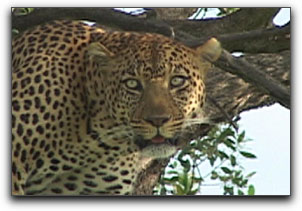
October 31, 2005
Lions, Tigers and Bears
Or
How to prepare for that first Video Safari
By Bruce Robison & Steve Douglas
You have finally decided to fulfill your life-long ambition and go on a safari to view and film the wild animals of Africa. Since you are going to spend a lot of money for airfare and the safari itself, you want to be able to bring back memories of your trip , share those experiences with your friends and produce professional, high quality video for presentations, film festivals, clients or competitions. You do not need the most expensive professional equipment to bring back high quality video of your experiences. You are already excited about going on the trip, but are you as prepared as you will need to be?

Cheetah after a kill
|
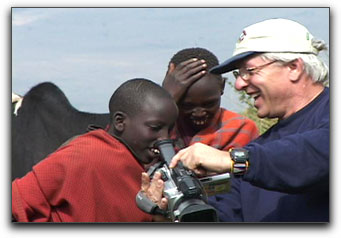
Showing video to Masi
|
Doing Your Research
There are some things that we need to get out of the way before we get into the "hows" of shooting safari video. These items are of the utmost importance to a successful expedition. Perhaps the most important consideration will be where and when you go on safari. You will need to research and decide the types of animals that you expect to see. Timing can also be critical. There are tree-climbing lions in some parts of Africa, a wildebeest migration to experience, different species of Zebra, Giraffe, rhino, birds, and many other species of animals that are specific to certain regions of Africa. Some places in Africa allow night game drives while, in other places, the game viewing will be confined to the daylight hours. There are destinations in Africa which allow for off-road driving and, in other places, you must stay on the road. It can be frustrating to see a special animal one-half mile away and not be able to get close to it because you are forbidden to go off-road. It is equally frustrating to go on a safari to Kenya in March to see the wildebeest migration and find out that the migration there occurs during July, August, and September (you have gone during the wrong time of the year). Safari rates can vary depending on the time of the year. Off-season rates are lower for a reason (too hot, too dusty, or too much rain to name a few of them). The lower rates for a certain time of the year can also be dependent on where in Africa you are going. Generally, the rates are lower December through April of each year.

Grevy's Zebra
|

Common Zebra
|
Accommodations
The second most important thing is the camp that you will be utilizing while on safari. The lodging can run from bare bones to very lavish. I have found that a tented-camp, where you are with the local people (Masi warriors in Kenya), has produced the best results for me during my many trips to Africa. The food in camp needs to be of the quality that will not produce stomach problems (nothing worse than a day in the loo while everyone else is out getting the fantastic shots).The water at the camp should be drinkable and not cause stomach problems. Bottled water should be available in the
vehicle at all times as it is very important to stay hydrated during your
safari. You will be close to the equator and it will be very easy to be
become dehydrated unless you drink lots of water during the day. Do not
take it for granted that water will be available. This is another reason for thorough research of your safari company.
The camp should have a source of electrical power for charging your batteries during your stay. There are several ways of charging batteries. Inverters can be run from the safari vehicle battery, or the camp may have a generator that they run sometime during the day or night. Solar cells can charge large storage batteries that can be used to charge your batteries.

Inverter for a vehicle
|

Propane generator
|

Solar panels
|
The guides and/or trackers should be local people from the area where you are staying. Too many drivers from some safari outfitters come from other areas just for the safari and do not know where the animals are located. These "imported" drivers tend to take a standard route and you may miss many of the exciting things that are going on.
Companion Compatibility
I should mention one more problem when shooting video. The "Curse of Ruined Shots" to a videographer is having someone else in the vehicle shooting a digital still camera with the flash turned on and the mechanical shutter blasting away. Your camcorder will pick up every whirr, buzz, click, pop and flash. Obviously, you do not want these extraneous sounds on your camcorder's soundtrack, especially if a lion is roaring for its harem and you want that roar as clean as the roar is loud. Ask the person to turn the flash and the shutter sound off, as more often than not, it does not accomplish anything. There is not much you can do about the mechanical noise if they are using their telephoto lens except to try to get in a vehicle without a photographer. If you want the natural sounds of the shot, other people with camcorders may also cause noise problems. Ask the person to turn the record on and off beep to 'off' on their camcorder.
It is also important that any other guest in the vehicle share a common interest in the same type of animals. I have been able to stay five hours shooting one subject and get some very special footage because I was the only one in the vehicle. Most times you will have to share the vehicle with other guests. However, it is always better if they are really interested in the animals and not just putting a check-mark by those that they have seen and want to move on to find another animal on their "I want to see" list.

Wildebeest crossing the Mara River
|

Hartebeest and baby
|
It should be understood that other people in the vehicle talking while you are shooting is also a "NO-NO", as this will also destroy the natural ambiance of your audio surroundings. I have found that if you explain the reasons why these precautions are necessary beforehand to any strangers or friends who may be assigned to the same vehicle, then they will be far more understanding and cooperative.
There are several varieties of vehicles that are used by the local safari people. There are pop-tops, canvas tops, hatch tops, and no tops to name a few. While the pop-tops give you better personal protection from the sun, they will not allow you get the extra elevation that you sometimes need. I prefer the hatch top, as it will allow you to rest your camcorder on the top or enable you to actually climb onto the roof of the vehicle for that extra elevation. Note: One should never ride on top when the vehicle is moving. I have helped treat people that have fallen off when a vehicle hit an unexpected bump. The vehicle should have four-wheel drive and be able to handle off-road driving chores. Crossing streams and, even shallow rivers can all be part of the experience and you don't want to get stuck mid stream. The canvas tops have the same elevation problem as the pop-tops.

Pop-tops
|

Open-sided
|

Hatch tops
Medical Preparedness
There are a number of vaccinations that you will want to consider before traveling to your destination. Your health care provider and The Centers for Disease Control and Prevention (CDC) are sources of information for vaccinations and other health related issues for specific destinations. Vaccinations for Hepatitis A, Hepatitis B, Rabies, Typhoid, Tetanus-Diphtheria, Measles, Yellow Fever, and one-time dose for Polio are all candidates for you depending on your travel plans. You could also be at risk for Malaria. There are several anti-malarial drugs available depending upon the areas that you will be visiting. Again, the CDC and your local health care provider can help you decide what is right for you.
Any prescription medications that you will be taking on the trip should be in their original bottles with the labels attached. Prescription medications should be in your carry-on luggage for the trip. Take extra medication as you may be delayed during your trip. Items such as Imodium, Pepto Bismol, and aspirin are all good items to have on any trip.

Elephant next to car
|

Eland on the savanna
|
Clothing
Another item worth mentioning is having the proper clothing for this safari sojourn. In addition to normal personal items, you should take long-sleeved shirts to protect you from the sun, a good, wide brimmed hat, and sun screen (you will be close to the equator). Most places will wash clothes for you, so you will not need many changes of clothes. Don't over pack with too many clothes. If you are traveling on a plane in Africa, you will have a weight restriction for your baggage.
Okay, we have gotten a list of "house-keeping" chores out of the way. It may seem like a long list; but they are critical and lead up to taking quality video on your safari. Let us take a minute to talk about the equipment that we will need for our safari:

Rhino and baby
|
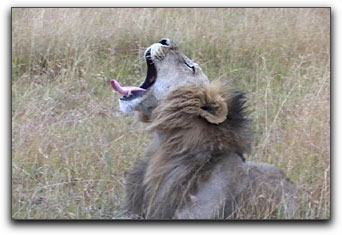
Lion yawning
|
Equipment
I would suggest that you completely and thoroughly check the gear you are taking on the safari several weeks before the trip. The only thing worse than finding out the day before the trip that something does not work properly is to discover that you did not bring it with you. I use a 3-chip rather than a 1-chip camcorder, as the colors are more vibrant. It is better to have a larger camcorder rather than a palm-size camcorder. A palm-size camcorder is easy to travel with; but, because of its lighter weight, it is more difficult to keep the camcorder steady. There are several ways to minimize the shake in the video while shooting. Monopods, tripods, beanbags, car mounts, and even a bundled up jacket help to steady the camcorder. It would be nice to use a large tripod on the ground; but that is not an option when you are shooting video of a female lion with cubs ten to fifteen away from you. Almost all of your shooting will be from the protection of the vehicle. I have found that with a larger camcorder it is possible to shoot rock steady video if you can be well braced in the vehicle. Of course, you cannot have other people moving around while you are shooting.

Monopod
|

Tripod
|

Bean bag
|

Car mount
|
Most companies that produce tape recommend that you use the same brand of tape as the brand of their camcorder. Their logic is that the tape was made for that brand of camcorder and is therefore better for that camcorder. I usually use 60-minute tapes so that I am not changing tapes all the time. This helps eliminate the risk of loosing some great animal behaviors. There are also times that I have videotaped a special animal behavior and do not want to risk loosing it or copying over it. I will stop shooting on that tape at an opportune time and put it away to make sure that it is safe and secure. Make sure to move the record tab to Save and label each tape. This will be a great boon to you in post production.

Lion with a cub
|

Waterbuck in forest
|
Take enough batteries for your trip. Batteries are relatively cheap compared to the price that you are paying for the safari. There are no Wal-Marts in the savanna! I always take at least three and usually four batteries should one can go bad on the trip. You will be using one and charging one and have two as backups if everything goes well. The batteries that have a longer burn time, naturally, are better.
Always check the charge on the batteries before going into the field. Countries in Africa have different types of electrical plugs and voltages of electricity than what you may be used to using. Make sure that you have the right type of plug for the country that you are visiting. The newer battery chargers are able to handle the differences in the electricity; however, most people will bring a converter to change the power from 220 volts to 110 volts just to be on the safe side. You will also need to be able to charge your batteries in the field. If you are staying in a tented-camp, you probably will not have an electrical outlet in your tent! Many camps provide power through a generator during the evening that you can use for charging your batteries. Some vehicles provide an inverter (or you can buy one for around $30) that will allow you to charge from the battery of your vehicle using the cigarette lighter plug. You will need to make sure that you have the right connections to attach it to your charger. As with bringing enough batteries, I always bring an extra charger. If you only have one and it goes out, you may be out of luck for the duration of the safari.

Electrical plugs
|
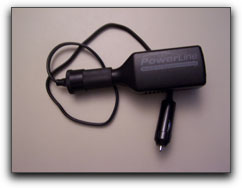
Inverter
|

Converter
|
Filters and Lenses
There are a variety of filters that are available for camcorders. I have found that I do better with just the plain glass filter (used to protect the lens) than changing around various filters and missing the shot that I want.
A wide-angle lens can be useful in shooting the inside of the tent or the group gathered around the campfire at night; however, a telephoto lens is probably a better lens to take on your trip. I usually use a telephoto lens sparingly as you are out of commission while changing lens. I have lost shots that I really would have liked to have had because I was in the process of a telephoto lens change when the leopard came out of the tree. On the other hand, I was able to get a fantastic close-up of the leopard's face while using the telephoto. Timing can be as important as luck when on safari.

Guides looking for lions
|

Hippo watching us
|
Protect That Camcorder
Rain protection for your camcorder is also essential. Sometimes you may have to shoot from inside the vehicle with the window rolled part way down. At other times that is impossible. Several companies make a cover for camcorders that offer some protection against the rain. I have found it awkward to get the camcorder into the cover, and the controls, difficult to reach and thus hard to manipulate. I always take some plastic bags that are big enough so that the camcorder will fit inside it. I put the camcorder in the bag with the lens sticking out the end and have found that it works very well. It is also less expensive. At other times, it is just raining too hard to use the camcorder at all and I just watch the action.
On Safari, one of the primary enemies of all camcorders is dust. In areas where the vehicle is in motion and there is dust in the air, you should cover your camcorder or put it in the plastic bag that you have for rain. The dust may get on the lens and inside the camcorder, which may cause problems that you cannot fix on site. Make sure that you have some way of cleaning your lens. I have had some great shots ruined while on safari due to unnoticed dust on my lens. These shots are worthless. Take a good kit for cleaning. Different people use liquid cleaners, cloths, special paper, compressed air, or brushes. I prefer the micro-fiber cloths, as there is no danger of getting liquid into your lens.

Camcorder cover
|

Camcorder in a plastic bag
|
Shooting with the Camcorder
There are several controls on your camcorder that may help you with your shooting. We will not go into all the functions you have at your disposal, however, the camcorder should be properly white balanced as the light in Africa can vary widely depending on the time of the day. The morning light usually produces the most pleasing footage. You should consider using Manual Focus rather than automatic focus where possible. Sometimes while in auto focus, the camcorder may not be able to separate the subject from its foreground or background resulting in an out of focus shot. Some camcorders have a feature that superimposes a rectangle on the screen of the camcorder and is useful for keeping the horizon straight.
If you are concerned about capturing the ambient sounds during your shooting, make sure your camcorder microphone is on "mic." A better way to pickup the natural audio ambiance is with a good external mic. You will be able to record a better quality of sound. Make sure you have a firm way of mounting that mic however. If it fits onto the hot shoe of your camcorder, great, problem solved. A windshield for the mic will cut down on the sounds of the wind during the shooting. You will find that the wooly bear type of sock does a better job than the simple foam models.
The last item about your camcorder is probably the most important; do not use the digital zoom if you can avoid it. It is great to say that you were able to zoom to 200x, but the quality of the video will significantly decrease and the odds of having a shaky picture will greatly increase. Get closer and use only the optical zoom or, if you cannot get closer, use your telephoto lens.

Rectangle on camcorder screen
|

External Microphone
|
Action
Speaking of zooming, you should try to stay away from it as much as possible. This is one of the more common errors from a new videographer. Shoot your establishing shot and turn the record off and into pause. Next, zoom to the medium shot and record. If you want a close-up, turn the camcorder off again and zoom in before turning the camcorder on. Proper editing in camera will save you time in post production. Nothing is more distracting than a video that is zooming in and out all the time. Sure, you can sometimes fix things when you are editing your video, but by planning the shot you will save yourself much time.

Warthog and friend
|

Topi in the early morning
|
The key to that special video is understanding and predicting how the animal will act and having the persistence and tenacity to wait for the behaviors you wish to catch. With proper understanding of the animal's behavior, it is sometimes possible to anticipate what the animal is going to do next. Since this is your first time on a safari, you must rely on your driver/guide. A good guide not only knows where the animals might be; but also can tell by an animal's body language what it is getting ready to do, such as hunt or mate or mark its territory.
You should be ready to film on a moment's notice. I have seen people loose a wonderful action shot simply by not being prepared and ready. Sometimes this ties into knowing what the animal is about to do. A guide can see a cheetah or a lion start moving in a certain way and know the animal has spotted something for dinner. The guide may even drive ahead and wait on the animal to approach its prey. You must be ready so that you will be able to capture the entire action sequence from the leopard stalking its prey, the chase, the take-down and resulting bloody carnage.
The animal behavior shot is something that you may see coming (lions mating); but it can also be a sudden unexpected action. This is another example of the need to always be prepared and on your toes. I have approached a tree with a leopard in it, when it dropped out off the branch onto a poor, unsuspecting wildebeest. I missed the shot simply because I was not ready.
The silhouette shot of animals or some of the African fauna with a sun rising or setting in the background can make a stunning picture. You should attempt to get as little of the ground as possible and a lot of sky. This will bring out the colors of the atmosphere in your video. Setting the cam on a beanbag or jacket, I frequently turn the camcorder on and remove my hands. Not having a hand on the camcorder I can avoid unnecessary jarring of the recording which results in a far more stable picture.

Silhouette of lion at dusk
|
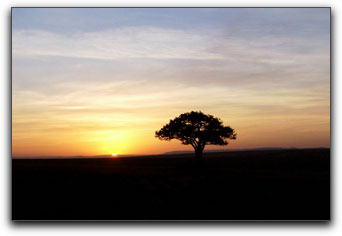
Evening shot
|
Shooting from a moving vehicle is something that you want to avoid in most cases. The only exception that I can think of is when a cheetah has chased an animal and made the kill and you are trying to get to the scene. A small clip of the kill scene as the vehicle is bouncing toward the Cheetah can add excitement to the video. The video will be bouncy; however, with your knees flexed, your body can offer some degree of stability which will certainly help the shot.
The time of day that you are shooting your video will produce a difference in the colors of your video. The morning light on the animals will provide a wonderful richness of color saturation. The same is true with the late afternoon sun; but to a lesser degree. The noon day sun produces less chance of shadows but tends to bleach out the more vibrant colors.

Lion cub in morning sun
|

Mating lions in noon sun
|
In most cases, the silhouette shot being the exception, you should avoid shooting towards the sun. You want to have the sun behind you to light your subject. Your subject should not have undesired shadows. You will have to pay attention to the shadow of the vehicle being in your picture as well.
When shooting video of people in any country, it is always a good idea to ask permission before rolling the camcorder. Most people do not mind having their picture taken; while some may be reluctant. In either case, it is the considerate and wise thing to ask first. I have been in some countries where even school-age kids told me that they did not want me to shoot video of them. You should respect their wishes.

Giraffe in the distance
|

Cheetah on the safari vehicle
|
Patience with your subjects can lead to spectacular footage. I had the opportunity, once, to shoot video of a dead elephant. Now who wants to shoot video of a dead elephant? I do now! I shot 5 hours of footage of this animal and all the other animals that came to visit. We had some 200 vultures, 50-60 hyenas, a pride of lions, and 10-15 jackals on an animal that had died of natural causes. When I thought I could shoot no more, the rest of the herd of elephants approached their sister and mourned over their comrade for 30 minutes before moving off. While I was shooting, one other vehicle came by and stayed for about 5 minutes and left. They missed one of the most amazing sights that I have ever experienced in my many trips to Africa.
It is our hope that through this article you have gained some insight into what to be prepared for before heading out on that first time safari. We have spent many years leading safaris as well as underwater filming expeditions. We didn't learn it all at once, but practice makes perfect. Safaris are expensive and there can be little worse than spending a small fortune on inter-continental air, intra-African air and the safari itself to be disappointed in what you see. We, unfortunately, have had to deal with some poorly run operations and have honed our own safaris so that no one is disappointed.
Good luck with your hunting. Remember shoot the animals with a camcorder and not a gun and bring back only good memories of your African expedition.

Pride of Lions
|

Cheetah on a safari vehicle
|
Bruce Robison has been shooting both stills and video for many years and has built up an underwater and African digital video library from many international locations. His diving adventures have led him to the Red Sea, Tanzania, Papua New Guinea, Truk Lagoon, Indonesia, Palau, Thailand, Hawaii, Coco Island, Galapagos, Tahiti, and all over the Caribbean. He has recorded the day-to-day lives of many of the wild animals in Africa from his numerous safaris to South Africa, Kenya, and Tanzania. His films have been broadcast on television and news broadcasts, and have been showcased in several film festivals throughout the USA. He and Steve Douglas, a regular reviewer for the Ken Stone and other editing sites, own World Films & Travel and take guests on diving and safari expeditions around the world. If you would like to go with Steve and Bruce, visit them at: www.worldfilmsandtravel.com
All wildlife pictures are single captured video frames.

WORLD FILMS & TRAVEL
[Top]
copyright © Bruce Robison & Steve Douglas 2005
© 2000 -2005 Apple
Computer, Inc. All rights reserved. Apple, the Apple logo, Final
Cut Pro, Macintosh and Power Mac
are either registered trademarks or trademarks of Apple. Other
company and product names may be trademarks of their respective
owners.
All screen captures, images, and textual references are the property and trademark of their creators/owners/publishers.






































